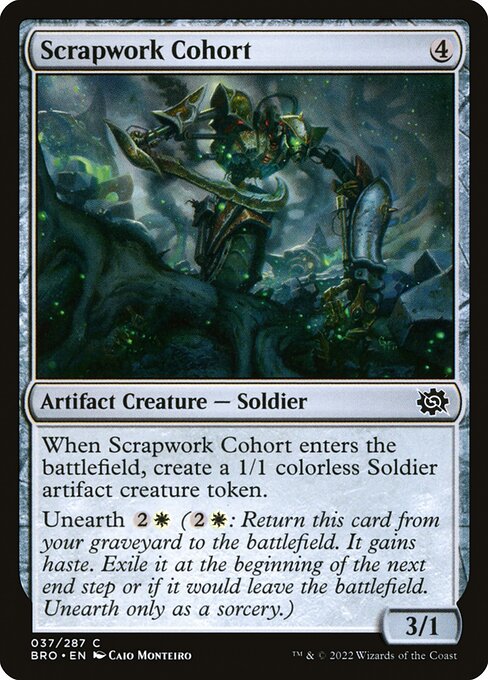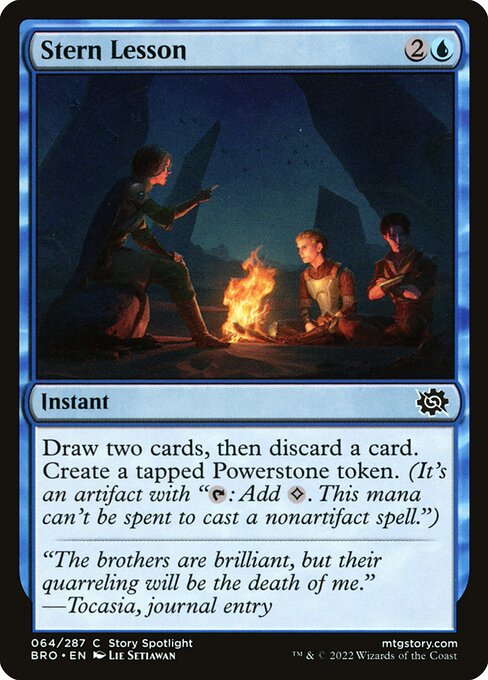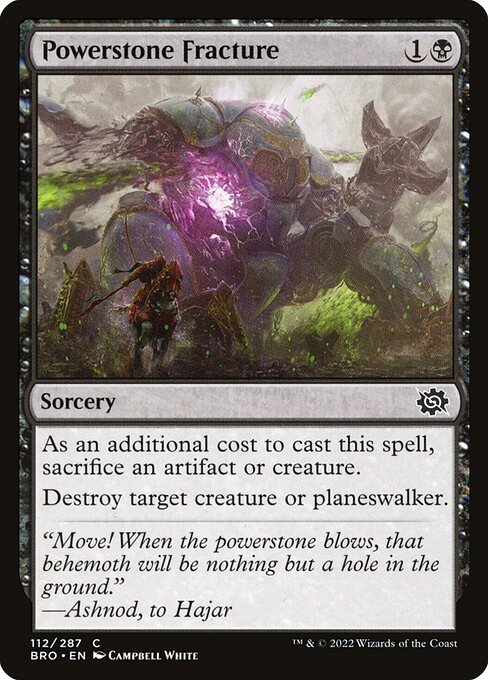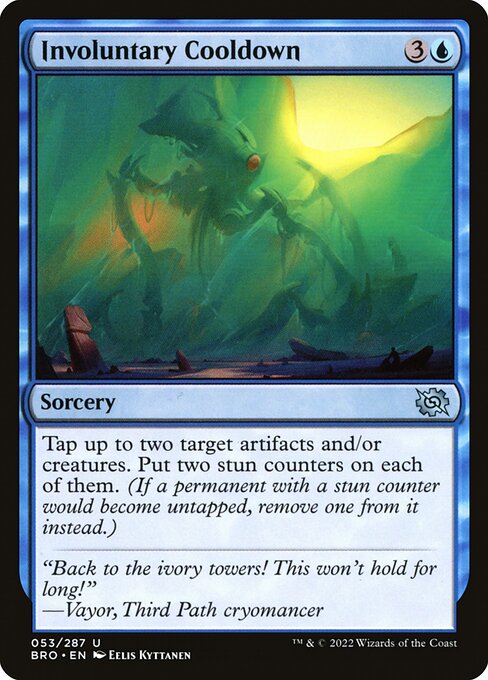Welcome back to another iteration of Mechanics in Review! Last time we tackled Dominaria United. Today, we’re catching up to the present (just in time for Phyrexia: All Will Be One‘s release) by reviewing The Brothers’ War’s mechanics. As ever, our primary focus will be on new mechanics, but we start by quickly reviewing the returning ones.

Shards of Eldritch Moon
The Brothers’ War featured two returning mechanics. Unearth got the lion’s share of attention, since it existed a rarities lower than mythic. It’s a great, simple mechanic—Flashback, but for creatures. It does somewhat constrain a set’s ability to use powerful Flicker effects, both due to rules confusion and recursion concerns, but the existence of Prototype (see below) ensured that there would never be any blinking of flickering in The Brothers’ War. I’ve got nothing but praise for the mechanic’s inclusion—it played well, it felt novel on artifacts, and it was an absolute flavor win. Seriously, it’s a set about two warring archaeologist-artificer-brothers digging up Thran war machines, getting them barely functional, and then smashing them against the others’ forces.
Meld was barely present in the set, only showing up on three rare/mythic rare pairs. It’s likely a very tricky mechanic to use at volume. It’s hard to make work in Limited, since players need to reliably get two different, face-up cards (though that would perhaps be easier to do in a Double Masters or Battlebond-style product where you get two draft picks). It’s also hard to balance properly—make the Meld too weak, and it’s a card disadvantage mechanic where you risk getting blown out for doing the cool thing. Make the Meld exceptionally strong (as is almost always the case) and you get an awesome reward for jumping through the hoops, but the game ends immediately (which means you don’t even get to play with the cool thing you’ve created). The fact that the set didn’t have room for a single common or uncommon pair like Graf Rats and Midnight Scavengers makes me pessimistic that we’ll see more lower rarity Melds any time soon.

The opposite of Unearth
Prototype is the first of The Brothers’ War’s two new mechanics. Along with Unearth, it allowed for old school-feeling artifact creatures with fully generic mana costs that improved when you had access to colored mana. But while Unearth rewarded you with a temporary burst of power if you found your colors late, Prototype functioned as a reverse Kicker that provided flexibility to your giant mechs when drawn too early. The two mechanics provided an interesting tension—Unearth rewarded you for splashing a color, while Prototype rewarded you for committing—yet they coexisted on very similar-looking cards.
Overall, I’m generally a fan of Prototype. I quite appreciated its play patterns and how it allowed decks to have massive plays that were functional in the early game (just like most Kicker mechanics). My biggest strike against the mechanic is its subtle complexity—paying the Prototype cost doesn’t merely change one always-relevant trait in a creature’s stats. Nor does it change everything the way that a Modal Double-Faced Card does. Instead, it changes some things (stats, mana value, and color), but nothing else. This leads to awkward templating on cards like Phyrexian Fleshgorger, some subtle rules interactions, and makes the mechanic harder to parse. I’m guessing part of this has to due with rules minutiae, like if Prototype were an alternate mana cost it would enable players to cheaply play a bunch of high mana value cards.
Ultimately, Prototype’s upfront complexity and confusion is a ding on an otherwise great mana sink mechanic. Prototype encouraged players to fill their decks with giant robots and be able to play them, which is exactly what the set was about (even if the highly assertive format often didn’t permit playing many non-Prototyped mechs). It had a phenomenal incentive structure as designed—if you reverse it so that cheap Prototype costs are colorless and the normal costs are colored, then everyone can play cheap Prototypes and probably splash their big forms late in the game. It makes the mechanic more powerful and each Prototype less interesting, since they all have similar play patterns and go in most decks (which is exactly the issue that Ikoria‘s implementation of Cycling had).

Don’t fail to not misunderstand
Powerstones were introduced in Dominaria United with Karn, Living Legacy, but they were finally explored in The Brothers’ War. Having played with them a lot, I’ve got a lot of praise for their gameplay, but am disappointed by their phrasing. Double negatives can be really confusing!
I understand that Powerstones are worded to be as short as possible. That’s appreciated in an era of 4+ line mechanics like Enlist, confusing mechanics like Cleave, and mechanics that do both (Mutate). But as worded, Powerstones use implication to design their function rather than explicitly spell out their use. In other words, they tell you the one thing they cannot do and leave it to you to realize that everything else is fair game (while priming you to only think about artifacts).
For the first several weeks of the format, I saw players (even highly enfranchised ones) repeatedly have “aha!” moments as they realized Powerstones’ basic functionality. It’s wonderful to give players opportunities to feel clever, but that’s best for lenticular designs where card combinations provide additional utility, not a mechanic whose basic functionality is unclear to many enfranchised players and outright confusing to newer players. The “aha!” moment should be realizing you can filter Powerstone mana into unrestricted mana with Chromatic Star, not realizing you can use Powerstone mana just to activate it.

Once over the substantial initial hurdle, I quite like Powerstones. I generally love artifact tokens, and Powerstones explore new space. Every prior type (done at volume, not one-offs like Nahiri, the Lithomancer’s Stoneforged Blade) was designed as single use—Clues, Blood, Treasures, and Food all sacrifice themselves and existed in economies built around sacrificing them. Powerstones are the first such token designed for multiple activaations. They could generate value turn over turn, created interesting deckbuilding incentives (they encourage artifacts and abilities, both activated and triggered), and still felt great as sacrifice fodder. Once you understood them, they had a fairly simple heuristic—Powerstone mana is less valuable than normal mana, so you should always use it first when able.
If anything, my second biggest complaint about Powerstones is how difficult they were to generate, and that’s really a compliment. They’re fun to use and powerful, so they should feel like rewards rather than free add-ons (as Blood, Decayed zombies, and Food were by virtue of being less powerful).
While my overall feelings are mixed on Powerstones, it’s because they have a lot to love and a fair bit to dislike, rather than there not being much there. This makes them far superior in my book to all of Dominaria United‘s new mechanics, all of which elicited few emotions from me one way or the other. And that’s an excellent opportunity to transition to drawing conclusions about both The Brothers’ War and its predecessor, Dominaria United.

Mechanics and fun
Last week, I was fairly harsh on Dominaria United‘s mechanics. This wasn’t because they weren’t DMU’s primary focus—I praised Kamigawa: Neon Dynasty for giving its spotlight to returning mechanics instead of new ones. However, NEO used new mechanics Modified and Reconfigure as glue to keep the set tight and interconnected, DMU’s mechanics were fairly disconnected from everything else. They felt more vestigial and perfunctory than essential. That was absolutely not the case with The Brothers’ War, whose new mechanics received the spotlight, coexisted nicely with Unearth, and created a coherent whole.
But mechanics are hardly the ultimate arbiter of a product’s quality. Despite my criticisms, Dominaria United edged out Kamigawa: Neon Dynasty as my favorite Premier Limited format of 2022. While I far preferred The Brothers’ War mechanical execution, loved its use of nostalgia and bonus sheet, and enjoyed its Limited format, it still came in third (in a very strong year for Limited, with Streets of New Capenna as a major outlier). Mechanics are only a single lens by which to evaluate products, and new mechanics are just a subset of that lens. That’s worth keeping in mind: it’s easy and often wrong to judge an entire thing by a portion of it, especially its weaker parts. The whole can be more (or less) than the sum of its parts.
And, as always, thanks for reading.
Zachary Barash (he/him) is a New York City-based game designer and the last commissioner of Team Draft League. He designs for Kingdom Death: Monster, has a Game Design MFA from the NYU Game Center, and does freelance game design. When the stars align, he streams Magic (but the stars align way less often than he’d like).

